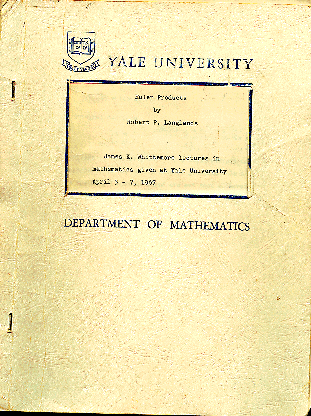Submitted by admin on
| Attachment | Size |
|---|---|
| 389.02 KB |

Editorial comments: The letter to Weil included a number of striking conjectures which eventually changed much of the direction of research in automorphic forms. Some of their consequences were explained in a graduate course given at Princeton in the spring of 1967, and then things were put in a somewhat wider context in a series of lectures at Yale later that Spring. These notes were previously published as the first of the Yale Mathematical Monographs.
Author's comments: This monograph was based on lectures given early in April of 1967 at Yale University, thus several months after the letter to Weil. None the less it is reticent about the conjectures formulated in that letter. Results are formulated in terms of the dual group introduced there, which could for the groups of the lectures be introduced without any reference to the Galois group because only split groups are treated. There is, however, only the slightest of allusions to any generalization of class-field theory: the observations that what can be done for one reductive group should be done for all and that the identification of an automorphic \(L\)-function with an Artin \(L\)-function or with a Hasse-Weil \(L\)-function is tantamount to a reciprocity law. These two observations underline that functoriality arose in an attempt to find a nonabelian class-field theory under the influence of the view, which arose in the early sixties, that much of the theory of automorphic forms could and should be treated in the context of group representations. The major technical impulse was the need for a concisely defined general class of Euler products that included those arising from the theory of Eisenstein series.
The formula (6), which is established in sufficient generality to verify the convergence of the Euler products, is not established in general, although it is surmised that it is generally true. This was, indeed, proved a little later in complete generality and, so far as I know, quite independently by Ian MacDonald (Spherical functions on a group of \(p\)-adic type). I had heard of his result, even though his monograph was not yet available, by the time Problems in the theory of automorphic forms was written, so that I could simply invoke it. The formula now carries, quite rightly, his name.
The formula referred to as the formula of Gindikin-Karpelevich was, indeed, proved in general by them, but had first been discovered by Bhanu-Murty and proved by him for the special linear group over \(\mathbf R\) in мера Планшереля для фактор-пространства \(\mathrm{SL}(n,\mathbf R)/\mathrm{SO}(n,\mathbf R)\), ДАН 133 (1960).
Although the notes for the lectures were available as a preprint at the time they were delivered or shortly thereafter, the monograph did not appear until 1970. Apart from the addition of one or two footnotes and the correction of misprints and slips of the pen, there were no alterations.
Gelbart and Shahidi have written a useful survey of the theory of automorphic \(L\)-functions, Analytic properties of automorphic \(L\)-functions. I recommend it to the reader of Euler products.